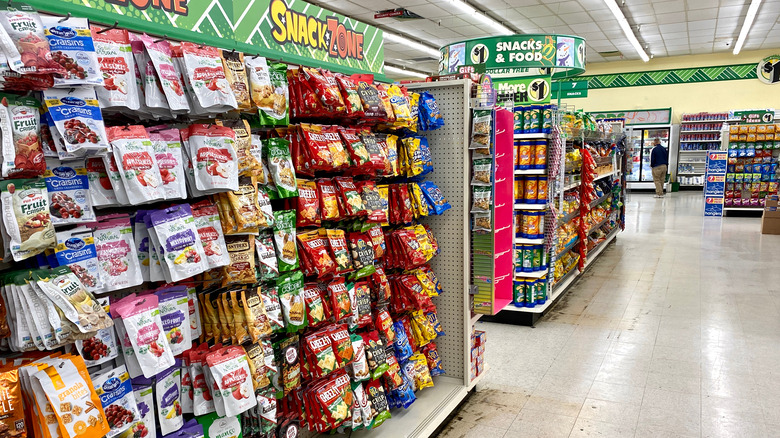How Food Inflation Is Making Dollar Stores More Popular Than Ever
It's already been one year since The Washington Post reported dollar stores were seeing an uptick in business due to rising prices at other retail stores driving them to seek less expensive alternatives. At the time, inflation was up 5.4% annually. Since then, inflation has risen to 8.5%, with supermarket prices up 13.1%, according to the Consumer Price Index. So, can you guess what people tend to spend most of their money on at dollar stores? That would be groceries, according to GOBankingRates. "When you only have a certain amount to spend, it's like, why not just go to the dollar store?" remarked one consumer who had transferred most of his local grocery store business to his local dollar store, to The Washington Post.
Indeed, Dollar General reported increased sales in consumable products (i.e., groceries) for its second fiscal quarter, according to its most recent earnings report, dated August 25, 2022. "We are pleased with our second quarter results," Dollar General's CEO, Todd Vasos told investors. Since last year, Dollar General's net sales increased by 9%, and operating profits by 7.5% – bolstered in part by an increase in foot traffic to all of its stores, both new and old. Over at Dollar Tree, which also reported Q2 results last week, net sales increased by 6.6% and operating profits by 25.7%, since last year (via press release). The question is, with inflation reducing consumer purchasing power, how is it that dollar stores are now doing better than ever?
Rising inflation has wealthier customers eschewing high end groceries
According to The New York Times, the dollar-store business model is meant to attract customers who have few other grocery shopping options because of either geographical constraints (e.g., rural customers) or low income, and it's meant to do so consistently throughout all economic conditions – including periods of high inflation, in which some customers will inevitably be struggling to afford increased prices (and inflation's stealth sibling, shrinkflation). With inflation having risen steadily throughout 2022 to nearly 9 cents on the dollar, however, a whole new customer base has discovered dollar stores: namely, higher-income shoppers. For example, at Dollar Tree, the average household income for new customers over the past year averaged $80,000. Back in December 2021, that number was around $60,000, according to CNBC. Prior to that, it was more like $40,000.
On the other hand, it's not all rainbows and unicorns for dollar stores. Whereas some retailers have increased retail prices to cover their increased expenses (thank you, supply chain snafus, among other things), some dollar stores, including Dollar Tree, have plans to actually discount their prices to remain competitive with big box stores. Competitors such as Walmart and Target have been forced to do the same to clear mounting inventory (and to make up for backlash from price increases last year). As a result, Dollar Tree ended up cutting its profits forecast for 2022, per Reuters. Dollar General, notably, did not reduce its 2022 profits forecast, per CNN.

